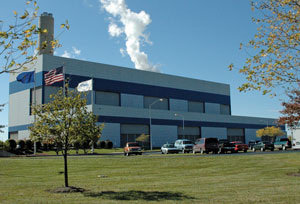Achieving Zero Landfill Goals by Tapping the 4th R—Recover
By Derek W. Veenhof | December 5, 2012
Category:- Energy from waste uses solid waste as a fuel to generate clean, renewable energy.
- EfW facilities export to the grid an average of 550 kWh of electricity for every ton of waste processed.
- Each year EfW facilities in North America prevent more than 25 million tons of greenhouse gases and CO2 equivalents from being released into the atmosphere.

As manufacturers continually look to implement practical sustainability strategies and increase environmental stewardship, addressing the waste steam has become a priority. As a result, zero-landfill goals have become popular with many manufacturers in many different industries, from food and automobile manufacturers to pharmaceutical and consumer product manufacturers. As they reduce waste, develop reuse strategies, and realize the value of key commodities by recycling, more companies are achieving zero or near-zero-landfill goals.
Many companies are making tremendous strides following the “3R” hierarchy—reduce, reuse, recycle—by reducing the amount of waste they produce through reuse programs; product design and restructuring of production and distribution systems; and composting and recycling. However, finding alternatives to the remaining landfill disposal can be the most difficult step for manufacturers looking to
meet their zero- or near-zero-landfill goals.
Increasingly many manufacturers are also looking to the “4th R”—recover—to sustainably manage residual waste left over after efforts to reduce, reuse, and recycle have been exhausted to help meet their zero-landfill goals and to recover energy (see Figure 1).
Energy recovery is the generation of electricity and steam in modern energy-from-waste (EfW) facilities equipped with state-of-the art air pollution control, efficient energy recovery, and metals recovery systems.
According to waste hierarchy models constructed by the European Union and U.S. Environmental Protection Agency (EPA), recovering energy from the waste that remains after reducing, reusing, and recycling is preferred over landfilling, even when landfill gas to energy is accessed. EfW facilities have served as successful partners with various companies in the automotive and consumer products industies and provide reliable service that these manufacturers count on day in and day out.
What Is Energy from Waste?
 Figure 2
Figure 2Covanta’s Indianapolis energy-from-waste facility serves the city of Indianapolis and Marion County, Ind., as well as many manufacturers and industrial companies.
Energy from waste, also known as waste to energy (WtE), is a process that uses solid waste as fuel to generate clean, renewable energy (see Figure 2). Waste is processed in combustion chambers where heat is converted to steam, which is exported to neighboring businesses and industries to be consumed or sent through a turbine generator to generate electricity (see Energy-from-Waste Process sidebar).
A common misconception is that the EfW process is the same as or similar to incineration. It is not.
Today’s modern EfW facilities are very different from incinerators of the past. Often the word incineration is associated with an uncontrolled combustion process without energy recovery. In contrast, the EfW process combusts waste in specially designed boilers and recovers usable electricity and steam. EfW facilities do this with some of the most sophisticated air pollution control equipment
available today and operate well below the strictest federal standards set by the U.S. EPA.
Another important distinction is that metals are recovered for recycling. In total, EfW facilities in the U.S. recover and recycle more than 700,000 tons of metals such as iron, steel, copper, and aluminum annually that otherwise would have been sent to a landfill. That’s equivalent to the amount of metal that would be used to build eight Golden Gate Bridges.
Best Applications of EfW for Manufacturers
The EfW process offers a number of benefits to manufacturers, and an increasing number of industrial companies are turning to EfW facilities to help them sustainably manage their waste and avoid landfilling. In contrast to landfills (which, unfortunately, continue to expand in the U.S. and have many negative health and environmental effects), EfW facilities safely generate electricity and steam, helping reduce greenhouse gas emissions, mitigate climate change, and assure destruction.
Energy Generation, Savings. According to the U.S. Energy Information Administration (EIA), energy use in America is growing. Many communities are looking to source renewable energy to help meet this increasing demand. While wind and solar power facilities provide intermittent amounts of renewable energy, EfW facilities are one of the most constant sources of clean power. They operate 24 hours a day, seven days a week, to provide reliable waste disposal and consistent base load power generation.
On average, EfW facilities generate and export to the grid 550 kilowatt-hours (kWh) of electricity for every ton of waste processed. That eliminates the need to generate the same amount of fossil fuel-based electricity and its accompanying GHG emissions. For each ton of waste processed, EfW facilities avoid the burning of 500 pounds of coal or 1 barrel of oil. Depending on the properties, the electrical generation could be higher or lower for a company’s specific waste stream.
Reduced GHG, Climate Change. Another benefit of EfW is that it offsets GHGs and helps combat climate change. According to the EPA, every ton of municipal solid waste (MSW) processed at an EfW facility prevents approximately 1 ton of GHG as carbon dioxide equivalents (CO2e) from being released into the atmosphere. This is a result of eliminating the methane that would have been generated at landfills; offsetting GHG from the equivalent fossil fuel electricity production; and the recovery of metals for recycling that do not need to be mined and processed. For more specific manufacturing and industrial waste streams, the GHG benefits will vary based on the composition.
Approximately 25 million tons of waste is processed at EfW facilities each year in the U.S., thereby preventing about 25 million tons of CO2 emissions from being released into the atmosphere.
Assured Destruction. Confidentiality, safety, and privacy often are concerns for manufacturers. They want to protect sensitive proprietary information, employee records, and financial statements from being exposed, or they may need to destroy pharmaceuticals, consumer products, or food to protect their reputation and brand and eliminate liability. By exposing all materials to temperatures about 2,000 degrees F, EfW facilities can guarantee the assured and certain destruction of sensitive materials.
EfW facilities can even safely dispose of liquid and semiliquid waste, providing a sustainable alternative to wastewater treatment facilities that may not be able to process some liquid wastes.
These facilities follow rigorous security protocols to help ensure thorough monitoring and control of the materials they process as they move through plants.
Advanced Emissions Control Technology
EfW facilities are among the most highly regulated power generation sources. They use state-of-the-art emissions control systems to thoroughly scrub and filter gases created during the combustion process as energy is recovered from waste. These plants continuously monitor emissions to ensure that the regulatory requirements that were established to protect human health and human safety are met.
The alternative—sending waste to a landfill—generates more than 170 uncontrolled air pollutants, including methane, which is 25 times more potent than CO2. On the other hand, EfW facilities are a net reducer of GHG.
Supporting Zero-, Near-zero-landfill Goals
EfW technology continues to evolve. The latest generation of facilities recovers more energy from the waste resource than ever before. Emerging technological innovations focused on gasification of unprocessed, postrecycled waste continue the evolution, offering the potential for greater efficiencies with smaller markets. A continued focus on innovation and best practices has helped make EfW the clean technology it is today.
Energy-from-waste facilities offer a safe, technologically advanced means of waste disposal while also generating renewable energy, reducing GHG emissions, and recovering metals. EfW providers are continually working to help companies around the world find sustainable solutions to energy and environmental issues and achieve their zero-landfill goals.

Side by side, we move metal fabrication forward.
FMA unites thousands of metal fabrication and manufacturing professionals around a common purpose: to shape the future of our industry, and in turn shape the world.
Learn More About FMA


